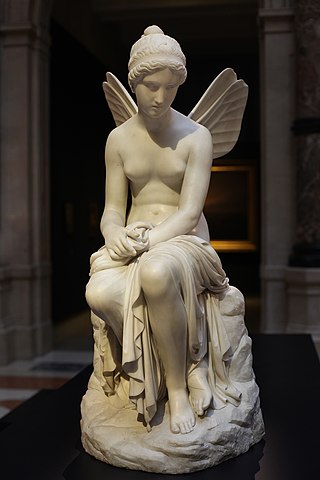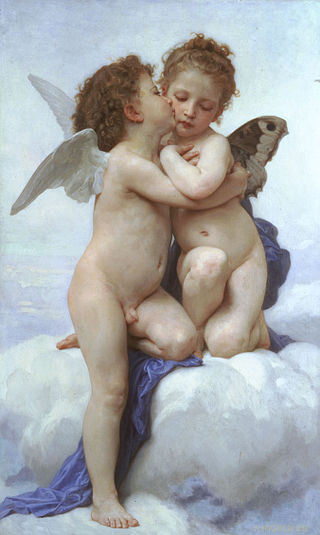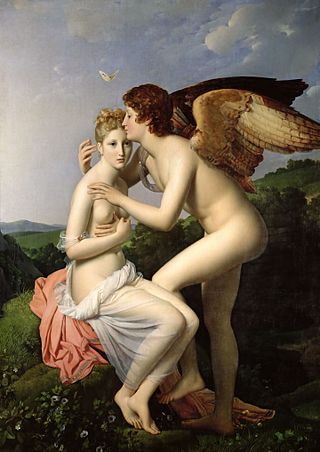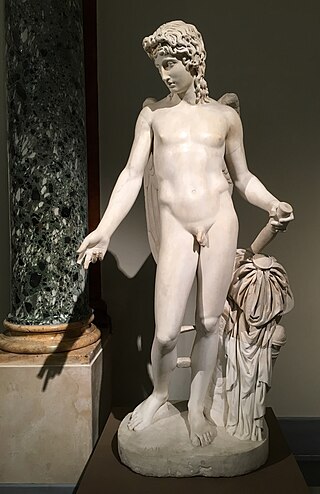
Angels have appeared in works of art since early Christian art, and they have been a popular subject for Byzantine and European paintings and sculpture.

Venus is a Roman goddess whose functions encompass love, beauty, desire, sex, fertility, prosperity, and victory. In Roman mythology, she was the ancestor of the Roman people through her son, Aeneas, who survived the fall of Troy and fled to Italy. Julius Caesar claimed her as his ancestor. Venus was central to many religious festivals, and was revered in Roman religion under numerous cult titles.

In Greek mythology, Anteros is the god of requited love and also the punisher of those who scorn love and the advances of others, or the avenger of unrequited love. He is one of the Erotes.

A cherub (; pl.: cherubim; Hebrew: כְּרוּב kərūḇ, pl. כְּרוּבִים kərūḇīm, are one of the unearthly beings in Abrahamic religions. The numerous depictions of cherubim assign to them many different roles, such as protecting the entrance of the Garden of Eden.

Psyche is the Greek goddess of the soul and often represented as a beautiful woman with butterfly wings. The name Psyche means "soul" in Greek and was commonly referred to as such in Roman mythology as well, though the direct translation is Anima. She was born a mortal woman and eventually granted immortality, with beauty that rivaled even Aphrodite, goddess of love. Psyche is known from the novel The Golden Ass, also known as Metamorphoses, written by the Roman philosopher and orator Apuleius in the 2nd century. In the myth, she was given multiple trials to be with her beloved, Eros, also known as Cupid, god of physical love and desire and son of Aphrodite. The cultural influences of Psyche's story can be depicted in art dating back to the 4th century BCE.

In Christianity, angels are the messengers of God.

Lama, Lamma, or Lamassu is an Assyrian protective deity.

L'Amour et Psyché, enfants is an oil painting executed by the French painter William Adolphe Bouguereau in 1890. It is currently in a private collection. It was displayed in the Salon of Paris in 1890, the year Bouguereau was President of the Société des Artistes Français. The painting features Greek mythological figures Eros and Psyché, sharing an embrace and kiss. Bouguereau was a classical-style painter in the Neoclassical era of art. The painting is characterized by the frothy background the figures delicately stand on. It depicts the beginning of the forbidden romance of Cupid and Psyche, a popular subject at the time of execution.

The living creatures, living beings, or hayyot are a class of heavenly beings in Jewish mythology. They are described in the prophet Ezekiel's vision of the heavenly chariot in the first and tenth chapters of the Book of Ezekiel. References to the sacred creatures recur in texts of Second Temple Judaism, in rabbinical merkabah ("chariot") literature, in the Book of Revelation in the Christian New Testament, and in the Zohar.

Eros is a concept in ancient Greek philosophy referring to sensual or passionate love, from which the term erotic is derived. Eros has also been used in philosophy and psychology in a much wider sense, almost as an equivalent to "life energy". The Protestant philosopher C. S. Lewis posits it as one of the four ancient Greek words for love in Christianity, alongside storge, philia, and agape.

Cupid and Psyche is a story originally from Metamorphoses, written in the 2nd century AD by Lucius Apuleius Madaurensis. The tale concerns the overcoming of obstacles to the love between Psyche and Cupid or Amor, and their ultimate union in a sacred marriage. Although the only extended narrative from antiquity is that of Apuleius from the 2nd century AD, Eros and Psyche appear in Greek art as early as the 4th century BC. The story's Neoplatonic elements and allusions to mystery religions accommodate multiple interpretations, and it has been analyzed as an allegory and in light of folktale, Märchen or fairy tale, and myth.

A putto is a figure in a work of art depicted as a chubby male child, usually naked and very often winged. Originally limited to profane passions in symbolism, the putto came to represent a sort of baby angel in religious art, often called cherubs, though in traditional Christian theology a cherub is actually one of the most senior types of angel.

Hybrid beasts are creatures composed of parts from different animals, including humans, appearing in the folklore of a variety of cultures as legendary creatures.

In Greek mythology, Eros is the Greek god of love and sex. His Roman counterpart is Cupid ('desire'). In the earliest account, he is a primordial god, while in later accounts he is described as one of the children of Aphrodite and Ares and, with some of his siblings, was one of the Erotes, a group of winged love gods.

In classical mythology, Cupid is the god of desire, erotic love, attraction and affection. He is often portrayed as the son of the love goddess Venus and the god of war Mars. He is also known as Amor. His Greek counterpart is Eros. Although Eros is generally portrayed as a slender winged youth in Classical Greek art, during the Hellenistic period, he was increasingly portrayed as a chubby boy. During this time, his iconography acquired the bow and arrow that represent his source of power: a person, or even a deity, who is shot by Cupid's arrow is filled with uncontrollable desire. In myths, Cupid is a minor character who serves mostly to set the plot in motion. He is a main character only in the tale of Cupid and Psyche, when wounded by his own weapons, he experiences the ordeal of love. Although other extended stories are not told about him, his tradition is rich in poetic themes and visual scenarios, such as "Love conquers all" and the retaliatory punishment or torture of Cupid.

In Ancient Greek religion and mythology, the Erotes are a collective of winged gods associated with love and sexual intercourse. They are part of Aphrodite's retinue. Erotes is the plural of Eros, who as a singular deity has a more complex mythology.

In Greek Mythology, Hedylogos was the god and personification of sweet-talk and flattery. He was part of Aphrodite's procession, and one of the seven Erotes, a group of winged love deities, along with Eros, Anteros, Hermaphroditus, Himeros, Hymen, and Pothos.

The Shaftesbury Memorial Fountain, officially and popularly known as Eros, is a fountain surmounted by a winged statue of Anteros, located at the southeastern side of Piccadilly Circus in London, England. Moved after the Second World War from its original position in the centre of the circus, it was erected in 1892–93 to commemorate the philanthropic works of The 7th Earl of Shaftesbury, the Victorian politician and philanthropist, and his achievement in replacing child labour with school education. The fountain overlooks the south-west end of Shaftesbury Avenue, also named after the Earl.
In Nonnus' Dionysiaca, Hymnus is a young shepherd who fell in love with the nymph Nicaea, was rejected by her, and ended up dying by her hand.

Amore-Attis is a bronze sculpture by Donatello of c. 1440–1443. It is 104 cm high and has traces of its original gilding, and is now in the Museo del Bargello in Florence.



















